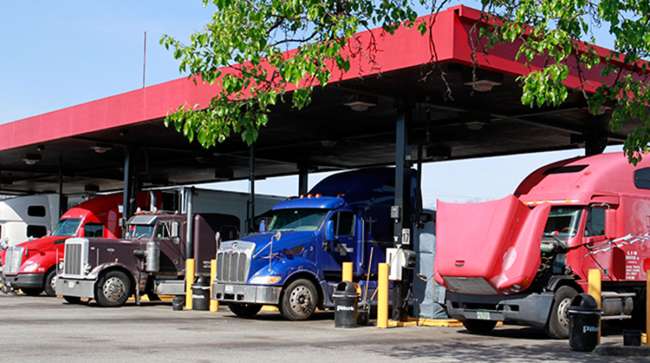Staff Reporter
Diesel Continues Slow Climb, Rises 0.4¢ to $3.734

[Stay on top of transportation news: Get TTNews in your inbox.]
The national average price for diesel continued to climb at a slower pace, rising four-tenths of a cent to $3.734 a gallon, according to Energy Information Administration data released Nov. 15.
Diesel has risen 2.1 cents a gallon over the past three weeks after surging 30.7 cents from Sept. 27 to Oct. 25. It now costs $1.293 more than it did at this time in 2020. EIA found that the cost of a gallon of diesel rose in five of 10 regions it surveys.
California experienced the largest price increase at 6.8 cents to $4.769. The state also has the highest diesel prices out of all of the surveyed regions. The biggest decline was eight-tenths of a cent to $3.474 a gallon in the Gulf Coast.

Kloza
“I think we’ve hit the pause button on the runaway rally, to a certain extent,” Tom Kloza, founder of the Oil Price Information Service, told Transport Topics. “We’re down about 20 cents a gallon from the peak prices for diesel in terms of wholesale. Unfortunately, when you’re looking at the markets and the markets have wholesale prices of $2.40 and $2.80, 20 cents doesn’t mean it’s a trend, it’s a pause. But the market looks a little bit toppy for the rest of 2021 until the winter either delivers or it doesn’t.”
The national average price for a gallon of gasoline dropped by 1.1 cents to $3.399. The West Coast saw the biggest increase at 4 cents to $4.169. The Midwest saw the largest decrease at 3.9 cents to $3.218.
“Gasoline prices looked like they were going to slump into the normal winter oblivion that they do,” Kloza said. “But both markets, gasoline and diesel, are contending with the loss of about 720,000 barrels a day of refining capacity that’s not coming back. You look at the two closures that happened in Louisiana.”
U.S. On-Highway Diesel Fuel Prices

EIA.gov
Phillips 66 announced Nov. 8 that it would turn its Alliance Refinery in Belle Chasse to a storage terminal next year. Hurricane Ida caused $1.3 billion in damage to the facility, prompting the decision. Royal Dutch Shell said Nov. 4 that it was closing its Convent Refinery.
“That’s a loss of about 720,000 barrels a day,” Kloza said. “I don’t think that’s going to be a big deal for the winter. But I think it’s going to be a big deal next spring for gasoline. The reason for that is that we’re going to see a couple of European refinery closures in the coming months.”
A colder than normal winter really helps diesel, because diesel is the product that gets substituted. It hurts gasoline because when it’s cold and it’s bitter and it’s miserable, people drive less.
Tom Kloza, founder of the Oil Price Information Service
Kloza added the U.S. is currently not seeing much of an impact from European gasoline production. But that could change come spring if those plants close. He noted that wouldn’t be a problem if the two Louisiana plants still were open.
“Normal winter, the pause probably turns into a wobble,” Kloza said. “A colder than normal winter really helps diesel, because diesel is the product that gets substituted. It hurts gasoline because when it’s cold and it’s bitter and it’s miserable, people drive less. Then if you really want to go out there, people are dismissing COVID a little bit too soon.”
President Joe Biden also is facing pressure to do something about fuel prices. Kloza noted that his administration could leverage the Strategic Petroleum Reserve to increase available crude and thus impact prices.
“That could be an SPR sale or it could be something else,” Kloza said. “I think they may opt to do something with the SPR like an exchange, which would be, we need some oil now to soften these markets. And we want people to bid for that oil.”
#TodayInEnergy - EIA forecasts crude oil prices will decline throughout 2022 #STEO #oilprices https://t.co/bwOZKBTAKF pic.twitter.com/RpSqkzb7In — EIA (@EIAgov) November 18, 2021
U.S. crude oil has been around $80 a barrel. But the price of crude is projected to be around $70 a barrel in December 2022. An exchange would mean that the U.S. government would sell some SPR crude now and would ask companies not to bid in terms of just price, but instead tell them to replace it next December, Kloza explained.
“The question is, what are you going to replace it at; it’s about a $10 difference,” Kloza said. “Whether or not it has a big impact on the markets is subject for debate. But I do expect that the administration, with the political pressure, does something. The lever that they could pull the easiest is going to be the Strategic Petroleum Reserve. It’s up in the air as to whether or not that would have much impact, and the impact would really be for early 2022.”
Want more news? Listen to today's daily briefing below or go here for more info:


